Huawei H12-831_V1.0 Übungsprüfungen
Zuletzt aktualisiert am 25.04.2025- Prüfungscode: H12-831_V1.0
- Prüfungsname: HCIP-Datacom-Advanced Routing & Switching Technology V1.0
- Zertifizierungsanbieter: Huawei
- Zuletzt aktualisiert am: 25.04.2025
As shown in the figure, an administrator configures static LSP between routers R1~R4. Which of the following configuration options are correct? (Multiple choice)

- A . [R2] static-lsp transit test incoming-interface GigabitEthernet 0/0/0 nexthop 10.0.23.3 out-label 300
- B . [R3] static-lsp transit test in-label 300 nexthop 10.0.34.4 out-label 400
- C . [R4] static-lsp egress test incoming-interface GigabitEthernet 0/0/0 in-label 400
- D . [R1] static-lsp ingress test incoming-interface GigabitEthernet 0/0/0 destination 3.3.3.0 24 nexthop 10.0.12.2 out-label 200
Which of the following operations does a network engineer not need to perform when processing a single-hop BFD session Dom?
- A . Repeat the display bfd statistics session all command to view the statistics of the BFD session sent and received packets.
- B . If a static route is bound to a BFD session, run the display ip routing-tab1e command to check whether the static route exists in the routing table.
- C . Run the display current-configuration configuration bfd command to check whether the local discriminator and remote discriminator at both ends of the BFD session match.
- D . Ping the link between the BFD sessions to check whether forwarding is normal.
The concepts of RD and RT are introduced in BGP/MPLS IP VPN network. Which of the following descriptions about RD and RT are wrong? (Multiple choice)
- A . RT allows the peer CE to decide which VPN routes to import into a specific VPN routing table
- B . RD can be used to distinguish VPN routes with overlapping address spaces
- C . RT allows the peer PE to decide which VPN routes to delete from a specific VPN routing table
- D . The IPv4 address with RD added is called VPNv4 address
In the network shown in the figure, R1, R2, R4, and R5 run IS-IS in area 49.0001. R3 and R6 run IS-IS in area 49.0002. Configure "import-route isis level-2 into level-1" on R2 and R5. Inside AS65000, R1, R3, R4, and R6 establish IBGP neighbor relationships with R2 and R5, of which R2 and R5 are RRs and R1, R4, R3, and R6 are clients. IBGP neighbor relationships are all established using the Loopback0 interface. The IP address of the Loopback0 interface of each device is 10.0.X.X/32, and the Router ID is 10.0.X.X, where X is the device number. R1 and R4 import the external network 192.168.1.0/24 into BGP, and R3 and R6 import the external network 192.168.2.0/24 into BGP.
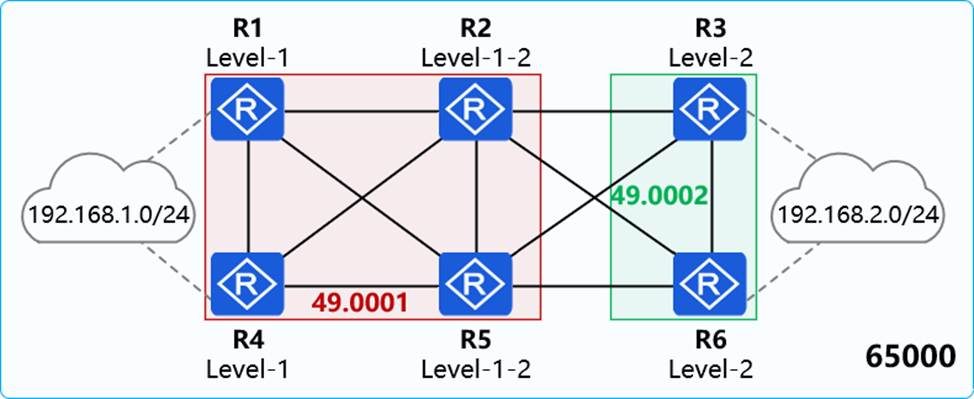
Which of the following descriptions are correct by default? (Multiple choice)
- A . There are two equal default routes in R4 routing table.
- B . There are two equal default routes in R1’s routing table.
- C . The route entry for 192.168.2.0/24 in R4’s routing table has two different outbound interfaces
- D . R1 routing table has a routing entry for 192.168.2.0/24
In the network shown in the figure, R1 and R2 have established an EBGP neighbor relationship through the Loopback0 interface. R1 introduces the route 2001::1/128 into BGP. In the Update message sent by R1, the value of the Next Hop field in MP_REACH_RI is 2000::1.
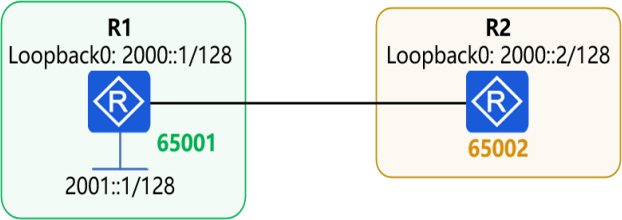
- A . True
- B . False
In the OSPFv3 network shown in the figure, area 1 is the Totally Stub area, area 2 is the normal area, and area 3 is the Totally NSSA area. The IPv6 address of the R6 Loopback0 interface is 2000:.6/128. The Router ID of each device is 10.0.XX, where X is the device number.
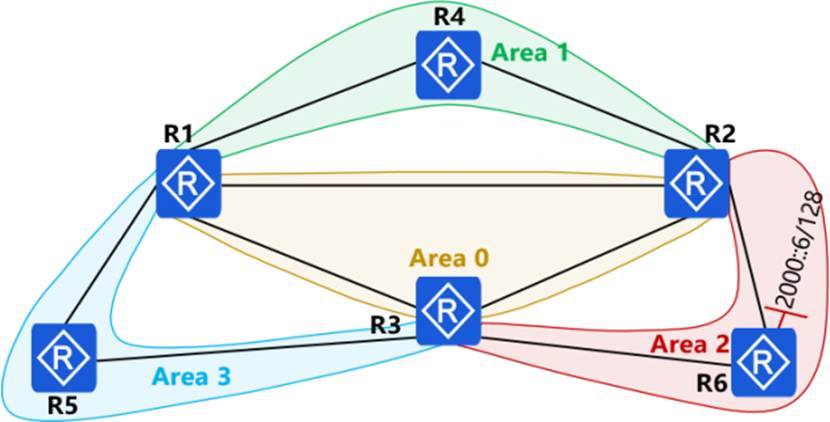
Which of the following descriptions is wrong?
- A . There is no route entry for 2000::6/128 in R5’s routing table.
- B . There is no route entry for 2000::6/128 in R1’s routing table.
- C . There is no route entry for 2000::6/128 in R4’s routing table.
- D . R1 will not generate an Inter-Area-Prefix-LSA describing 2000::6/128
If the technical migration actions performed on the network will affect the existing network operations, the pre-set operating procedures and risk control measures must be strictly followed when implementing the technical migration project. Such projects are generally defined as cutover projects.
Which of the following operations performed in the existing network is a non-cutover item?
- A . Change the level of IS-IS Level 1-1-2 routers to Level 1-1 in batches
- B . Modify the description information of router interfaces in batches
- C . Change the area type of some OSPF routers to Stub area in batches
- D . Change the method of importing routes into BGP in batches from network to import
After troubleshooting the problem, the network engineer wrote a troubleshooting report, in which he simplified the actual networking into the network shown in the figure.
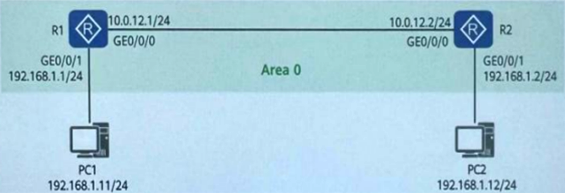
R1 and R2 both have OSPF enabled and serve as gateways for PC1 and PC2 respectively. Which of the following descriptions are correct? (Multiple choice)
- A . If the OSPF function is disabled on R1 GE0/0/1, R1 can ping 192.168.1.2.
- B . PC1 and PC2 cannot ping each other
- C . If the R1 GE0/0/1 interface fails, R1 can ping 192.168.1.12
- D . If the R1 GEO/0/1 interface fails, R1 can ping 192.168.1.2
In the network shown in the figure, the DHCP Server function is enabled on the R2 GE0/0/0 interface, and the address pool is the global address pool. The R1 GE0/0/0 and GE0/0/1 interfaces are used as DHCP clients. By default, only one interface can obtain an IP address.
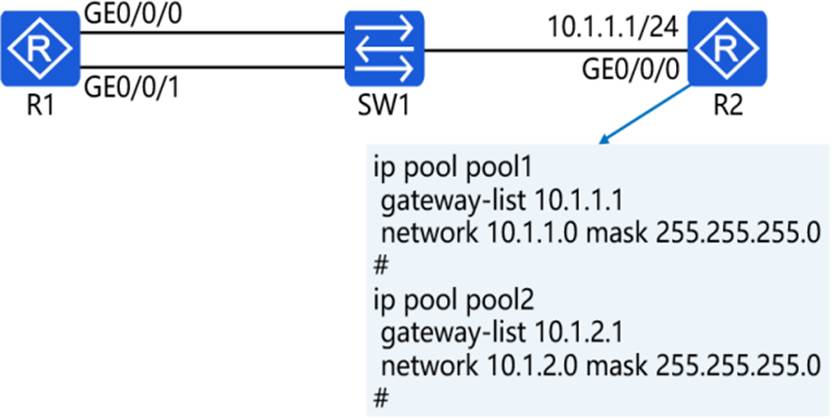
- A . True
- B . False
In the network shown in the figure, R1 and R2 are configured with single-hop BFD detection. The network engineer found that the BFD session was Down, so he queried the configuration related to R1 and R2 BD. The configuration information has been marked in the figure. According to the configuration information, the reason for the BFD session Down is that the time parameters configured on R1 and R2 do not match.

- A . True
- B . False
